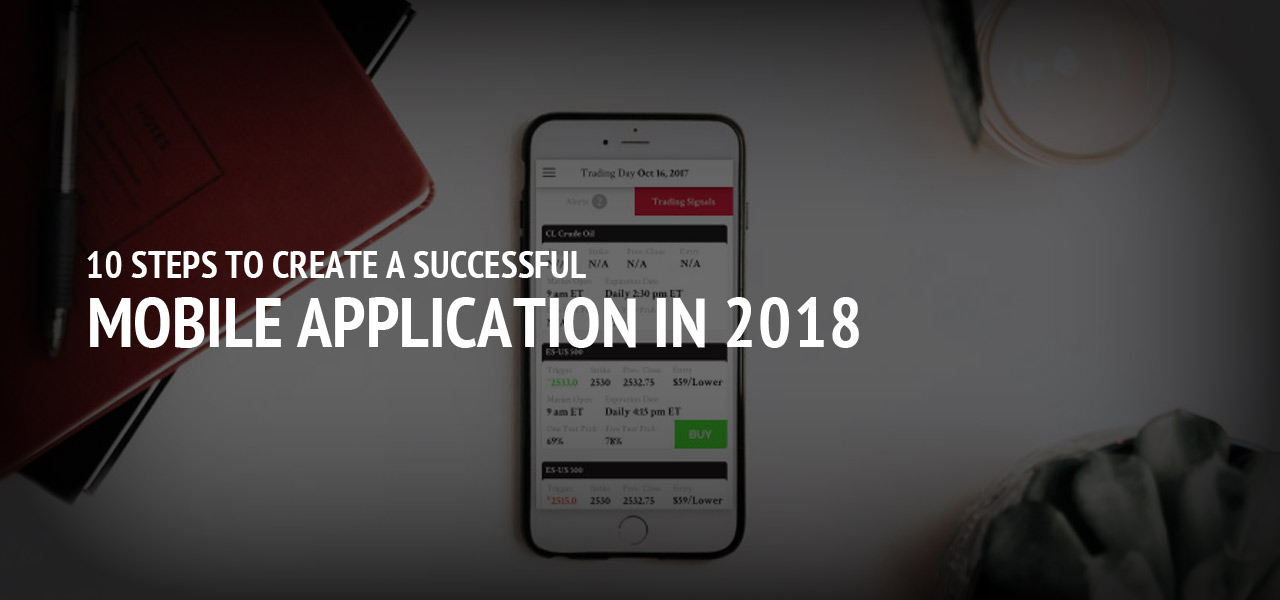10 Steps to Create a Successful Mobile Application in 2018

Recently, there has been a paradigm shift from the use of websites to the use of mobile applications. This has led to a ferocious competition in the mobile app market as different companies and individuals clamor to meet up with the technological revolution.
Mobile apps have grown to be a necessity to businesses, companies, individuals, etc as it generates more conversions for owners.
According to www.statistica.com, as of March 2017, 2.8 million apps and 2.2 million apps were available at Google Play Store and Apple Store respectively, with thousands being added daily.
With this statistics arises the problem of app visibility for a new mobile application breaking into the market. There's need for you as a new app developer to develop a methodical approach to mobile app development. This has a big role to play if your app is to survive the breakeven point in the market.
Never to worry, we've outlined ways to develop an app successfully.
Below are 10 steps to create a successful mobile application.
1) Problem Identification and Definition
Before you start any mobile app venture, be it for gaming, e-commerce, etcetera, you have to ask yourself the question, "What needs are my solving?"
Understanding the need is the first thing an intending app owner should know. This keeps you in view of where you're heading to and what you're aiming to solve.
With an understanding of the problem, you go ahead to define the exact aspect of the identified problem your app will solve. This helps give objectivity to the purpose of your mobile app.
With identification and definition of the problem comes conception of creative ideas on features. These conceived features have to be directed towards solving the defined problem. The features of the app should be a reflection of the problem you're trying to solve.
After the stage of definition, you proceed to the next step.
2) Market Research
Immediately following the problem identification is the market research. This is surprisingly the most important step in the process of developing a mobile app.
How can you carry out an effective market research?
- You can start by sorting through other mobile apps in app stores in search of competing apps. This will help you make your app as near unique as possible.
- Research and have a clear picture of your potential target audience. Develop a persona for this audience; this will guide you in developing the right app for the right audience.
- Select platforms and devices to be supported by the mobile app. This should be done having core mobile specifications in mind. Factors to be considered here include; battery life, hardware performance, coverage, operating system version among others.
- Engage your potential audience in conversations for their honest feedback. Ask them if the app idea is something they'd love to get. Do they use similar products? What will motivate them to switch to your app? Are they willing to switch?
Market research will go a long way to help you understand the market better for effective and optimal mobile app development. Make adjustments to your idea based on the information got from the market research. It's necessary to align your ideas with existing successful apps.
3) Develop a Business Model
Every mobile app has a rationale behind its development. How will your app achieve its purpose? What's your strategy to achieve your aim of developing the app? If you plan to make money out of the app, Will people pay to download your app? Will you allow PPC or other advertising packages? If yes, will the advertising interfere with the user experience?
With the answer to these questions, you can develop a business model which will guide the app development process.
4) Set a Budget
Make sure you have an accommodating budget for the app. There's great need to map out a budget for development and marketing of your app. It's also of great importance that you allocate a good percentage of the budget to contingencies. It's normal for the first version of your app to be imperfect, thus need to budget for the iterative refinement of your app.
The major things to consider during mobile app development budget include;
- App Functionality and purpose: The major purpose of the app is a top determinant of the app development budget. Uses of mobile apps are broad and diversified; the budget for a gaming app can't be compared to that of a texting app. Having a great grasp of the functionality of your app determines this aspect of budgeting.
- Mobile Platforms and Devices: Having a good knowledge of mobile platforms, understanding the purpose of your app and having in full view the behavior of your potential app users goes a long way to determine the operating systems to be supported by your app. The operating systems supported goes further to determine the development time and cost of your app.
- Each platform is unique and requires some app modifications for compatibility. Developing your app for a particular platform, or all has a big impact on your budget. Compatibility of the device plays an important role here too.
- Integration Points: Which other systems does your app need to integrate with? Where will the content come from? Which graphics format will be integrated? Will it have access to devices' hardware features like GPS, gyroscope, camera etc? All these play a role in determining how you approach the budgeting and with time the design of the application.
- Maintenance: What's your plan for maintenance? Will the app be maintained and upgraded with time? Make plans to upgrade your app and plan for upgrade frequency.
5) Design App
This is another significant step in the success of an app in the mobile market.
Many developers say they want a basic design and focus more on app development. This is a wrong step. Mobile app design doesn't only consider the app's look, it puts into consideration user's experience and appreciation of the app.
There's need for you to focus on the UI (User Interface) design and consider the standards of the platform the app is meant for. UI is being emphasized because of its critical relevance to an app's success. The UI is the most important element of the app.
While making the design, it's sacrosanct to focus on usability, user requirement, agile methodology, security, and back-end environment.
You should choose the perfect programming language for the intended app. iPhone app developers prefer Objective-C for developing android apps while Android app developers find HTML5, CSS and Javascript more suitable for Android apps.
These languages help programmers design apps that will run across platforms, and this is done having the mobile devices and user's convenience in mind.
6) Prototype Development
After designing your app, next step is the prototype development stage. This is taking your idea and turning it into an application with basic functions. The prototype presents an easy avenue to sell your idea to potential users. Prototyping is important in attracting investors, manufacturers and in acquiring licenses.
7) Mobile Analytical Tool Integration
With innovations popping up every day in the IT world, many new ways of monitoring web and app statistics abound. Analytics is the mother of data science as it helps you track downloads; monitor the traffic to your app and the source of the traffic.
Mobile analytical tools go ahead to show the rate at which users leave your app (bounce rate) when they visit, and if they stay, how they behave while logged on and also informs you if they come back to your app.
With this information, you can modify your app to suit your audiences' preference.
Mobile analytics tools that help in this process abound. They include;
- Firebase: Firebase is built on Google infrastructure and gives functionality like analytics, databases, messaging and crash reporting. It's free and unlimited.
- Localytic: Localytic gives you the insights and tools you need to improve your mobile app acquisition, engagement and retention efforts.
- Mixpanel: Mixpanel keeps all your metric in one place. It keeps you up to date on trends, funnel conversion rates and retention rates. It provides tools for targeted communication with your audience. Its app contains A/B tests and user survey forms.
- Flurry: This is owned by Yahoo. It helps you measure, monetize, advertise and improve your apps.
After integrating the selected analytical tool, your app is ready for the next step.
8) Testing and Modification
This stage of the app development process involves conducting tests to check the functionality of the app. Stern and continuous testing of the app is important to ensure the app functions as outlined in the blueprint.
These tests include;
- Simulation and emulation test: Here, a simulator is used to test the app for errors and bugs. This is done to ensure that the app functions properly and is fit to be sent out to mobile app stores.
- Beta Testing: After the simulations, the app is ready for the first human test. The beta test is the first contact the app has with the target audience.
This is essential as it enhances app store visibility and creates an avenue to get feedback from real-time users. You'll consider some preparatory steps before you carry out a beta testing;
- From the market research conducted at the beginning of the app development process, you'll identify and define the target audience. This audience will form your core beta testers.
- Alpha Testing: This is done prior to beta testing. It's carried out with a small number of the app uses to clear bugs. It's advised that this is done having specific bug eliminator devices in mind.
9) Market Your App
At this stage, the app is ready and is released into the market. This point requires utmost tactfulness, as many apps exist in app stores.
It's challenging to break into the market and be noticed by the target audience.
To achieve this feat, you need to plan, schedule and control the movement of app releases, to test and the live environment. It's of great importance to manage the app's deployment alright so the app will enter the market at the right time, for the right audience while maintaining its integrity.
10) Innovate
As nobody's perfect, so is no app perfect. After app deployment, need arises to listen to your users and find out what they enjoy and what they don't in the app. Take recommendations and criticisms of the app. This will help you plan your innovations perfectly.
One may ask, "How do I get this information?"
By Capturing the Metrics!
Accurate metrics are required for an accurate app innovation. As the number of mobile app users rises significantly, the need to collect accurate metrics rise simultaneously.
Most of the app intelligence that'll be gathered at this stage originates from the mobile analytics integrated into the app. Some metrics which should be monitored include;
- The aspects of your app users share the most on social media and other platforms. This metric highlights the aspect of your app that captures users' attention most.
- Funnel analysis to discover why users fail to complete the call to actions in your app.
- Correlation of user behavior and the demographic data from the analytics.
- Tracking the origin cum country where you have the highest number of app users.
- Tracking time and location of users. This gives an insight into the forms your app is used.
- Capturing the behavior of your app users while on your app.
These metrics captured make your guiding factors during the upgrading process. Innovations are added to the app with each upgrade, as innovative features determine to a high extent the longevity of your app.
App upgrading enhances app visibility, increases downloads and prevents stagnation of app. The app should be upgraded also to meet new guidelines offered by various platforms as the platforms innovate.
As an app developer, there is great need to follow innovations in the platform your app is running on. These innovations must reflect with each upgrade made on your app.
Conclusively, there is no stereotyped order of particular steps that lead to the success of a mobile app.
However, these steps outlined are some of the steps you should consider while developing an app. These steps will guide you develop an app that will survive in the long run.
About The Author
Related Blog
View All-
What is leasing
What is leasing and how does it work Leasing is a financial solution for businesses and individuals; a service with which you can take a long-term lease of property with the possibility of its further redemption. It looks like both a rent and an analogue of a ...
-
A definitive guide to creating Smart Mobile App on Blockchain
What is blockchain technology? The blockchain (or chain of blocks) is an information storage and transmission technology; transparent, secure, and operating without a central control body. Sometimes, by extension, the 'blockchain technology' is presented ...







